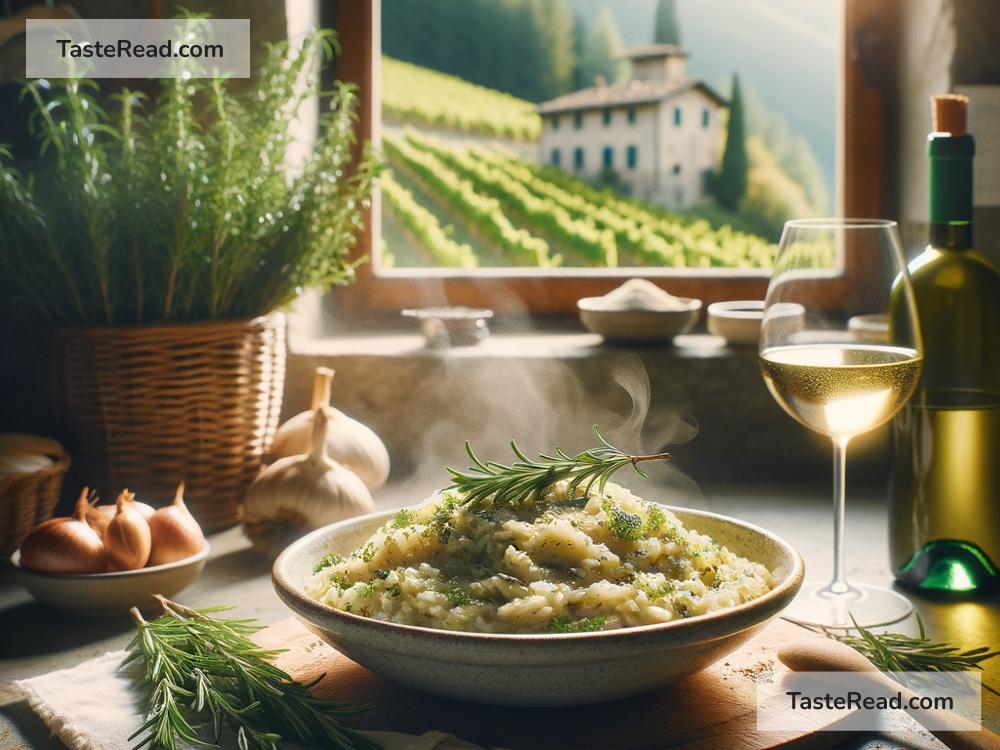Journeying Through Aromatic Herb-Infused Risotto in Northern Italy
When you think of Northern Italy, images of rolling hills, picturesque villages, and hearty meals might come to mind. However, among the region’s culinary treasures, there’s one dish that perfectly embodies the flavors of local ingredients and the love of cooking: herb-infused risotto. This creamy, comforting dish reflects Northern Italy’s rich history, connection to nature, and dedication to flavor. Let’s take a journey through this delightful recipe and explore how Northern Italy brings it to life.
A Culinary Legacy Rooted in the Land
Northern Italy is known for its rice production, especially in regions like Lombardy and Piedmont. The Po Valley, with its flat plains and ample water supply, is ideal for growing rice. Rice was introduced to Italy centuries ago, and the locals quickly adapted it into their cuisine. Risotto—the iconic rice-based dish—was born out of this agricultural tradition.
Risotto is unique because of the way it’s cooked. Unlike other rice dishes that might simply boil or steam the rice, risotto involves slowly stirring the grains while they absorb broth. The result is a creamy and luxurious texture, which makes the dish so satisfying.
Herbs, which are an essential element in Northern Italian cooking, play a starring role in risotto. From fresh parsley to fragrant thyme, herbs elevate the dish’s aroma and pair perfectly with the creamy rice base. They bring a piece of the Italian countryside directly to your table.
The Heart of Risotto: Quality Ingredients
One of the secrets behind Northern Italy’s remarkable risotto is the focus on high-quality, fresh ingredients. Locals take pride in sourcing produce and herbs from their surroundings. When you order risotto in Northern Italy, it’s not uncommon to find dishes made with wild herbs that were foraged just hours before cooking.
The rice itself matters too. Arborio, Carnaroli, and Vialone Nano are three popular types of risotto rice grown in Northern Italy. These specific varieties are prized for their ability to absorb liquid without becoming mushy. Their firm texture contributes to the dish’s perfect consistency—creamy yet with a slight bite.
In Northern Italy’s herb gardens, basil, rosemary, sage, and chives often steal the spotlight. Each herb gives risotto a unique flavor. For example, basil adds a sweet, peppery note; rosemary brings warmth and earthiness; and sage creates a slightly bitter, almost buttery taste. When combined with the rich broth, these herbs turn an ordinary plate of rice into something extraordinary.
The Craft of Cooking Risotto
Making risotto isn’t just cooking—it’s an art form. It’s about patience, love, and attention to detail. If you’ve ever prepared risotto yourself, you’ll know the importance of stirring constantly. This technique allows the rice to release its starch, giving the dish its creamy texture.
The process typically begins by sautéing onions or shallots in olive oil or butter. As the aroma fills the kitchen, the rice is added, allowing it to toast slightly before the liquid is introduced. The broth is added in small amounts, ladle by ladle, as the cook stirs diligently until it’s absorbed. During this stage, fresh herbs are often added, infusing the dish with their fragrance.
Though risotto requires care and time, it’s not an intimidating dish to make. In fact, its simplicity is part of its charm. You don’t need fancy kitchen equipment or expert skills—just fresh ingredients and a willingness to savor the process.
Herb-Infused Risotto Variations in Northern Italy
Northern Italy offers a variety of herb-infused risottos, often tailored to the herbs or produce available in the season. For instance:
-
Risotto alle Erbe: A simple risotto featuring a mix of fresh garden herbs, olive oil, and Parmesan cheese. It’s light, refreshing, and a celebration of the countryside.
-
Risotto al Rosmarino: This version focuses on rosemary, paired with a hint of lemon zest to brighten the dish. It’s understated yet full of flavor.
-
Risotto al Timo e Funghi: Thyme and mushrooms are the stars of this earthy risotto. Wild mushrooms from the nearby forests often elevate the dish, making it a favorite in autumn.
-
Risotto alla Salvia e Mascarpone: Sage and rich mascarpone cheese create a velvety, creamy risotto that melts in your mouth. It’s indulgent and perfect for special occasions.
Each region and chef may put their personal spin on risotto, but the use of seasonal herbs and locally-sourced ingredients remains consistent.
Discovering Risotto in Northern Italy
While you’re exploring Northern Italy, you’ll find risotto on restaurant menus, in cozy trattorias, and even at family tables. Locals are passionate about food and love sharing their cooking traditions with visitors. During your journey, don’t miss the chance to try risotto paired with other Northern Italian delights, such as crisp white wines, rich cheeses, or fresh salads.
If you’re lucky, you might be invited into someone’s home for a meal. Here, you’ll gain insights into how risotto is prepared and shared among loved ones. Food, after all, is a way of bringing people together.
Bringing Northern Italy to Your Kitchen
Even if you’re far from Northern Italy, you can recreate herb-infused risotto in your own kitchen. Start with high-quality risotto rice and fresh herbs. Let yourself slow down—cooking risotto is about enjoying the process as much as the result. With each stir and each bite, you’ll capture the essence of Northern Italy: simple, fresh, and full of heart.
Northern Italy’s herb-infused risotto is so much more than just food; it’s a celebration of tradition, nature, and the joy of cooking. Whether you’re traveling through Italy or preparing it at home, this dish will always transport you to the fragrant gardens and warm kitchens of the north. Happy cooking—and happy eating!


